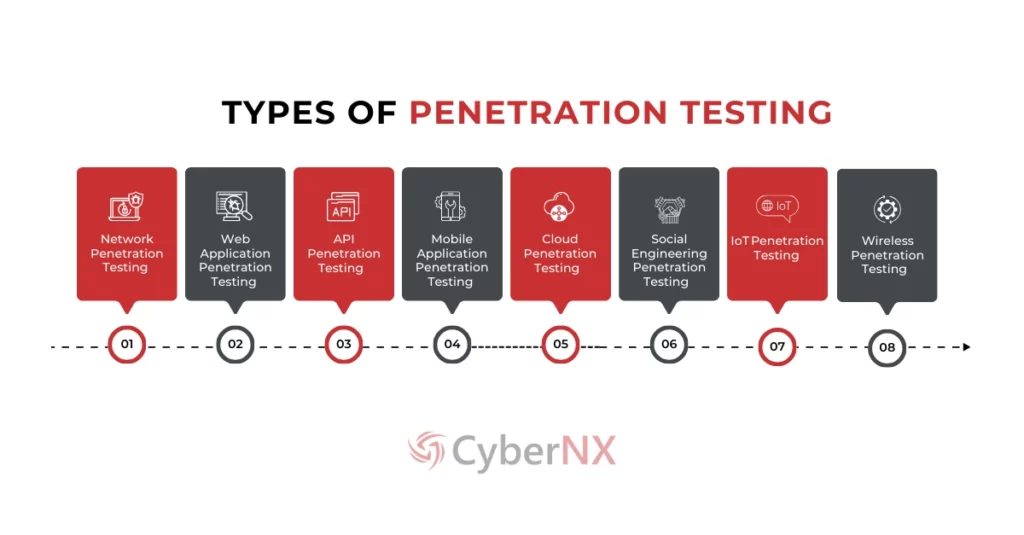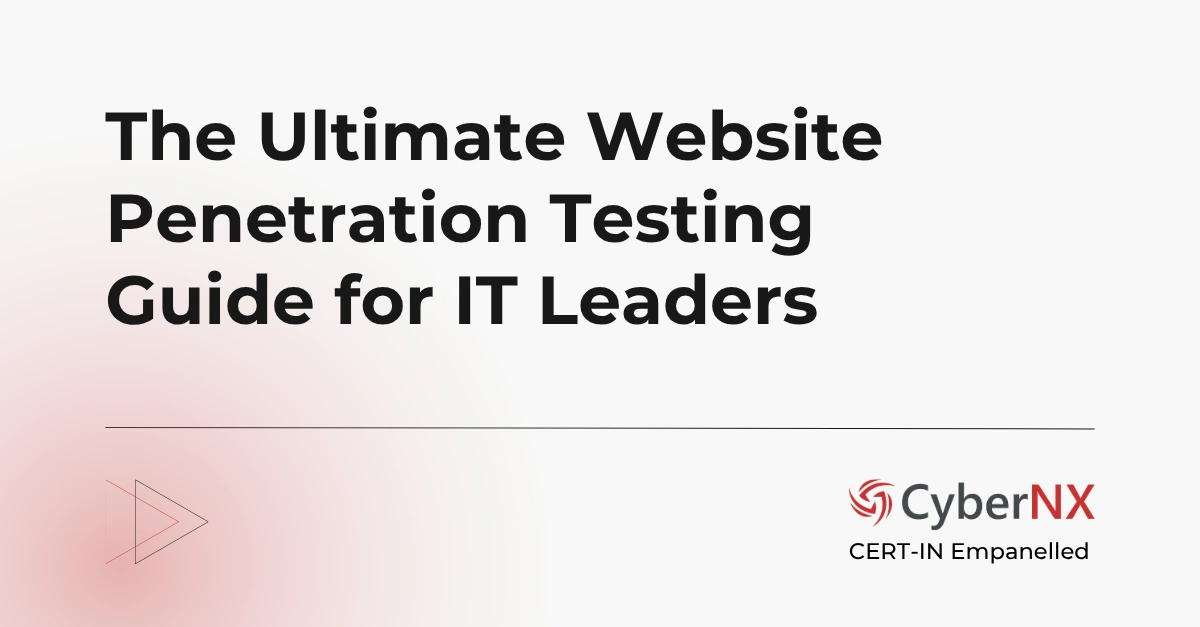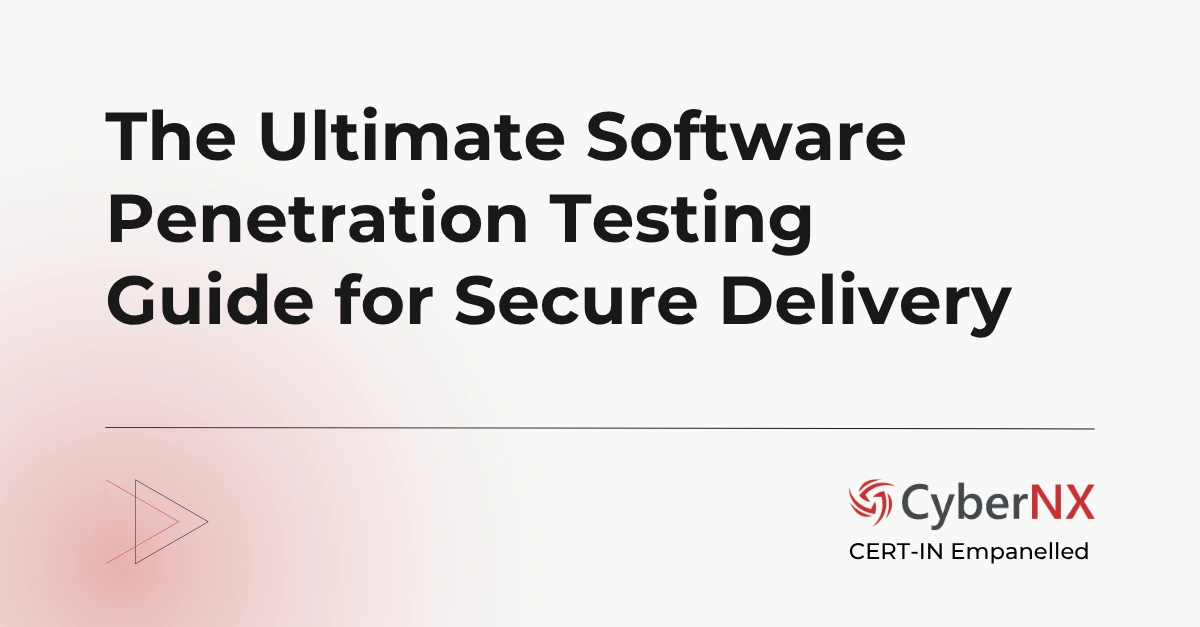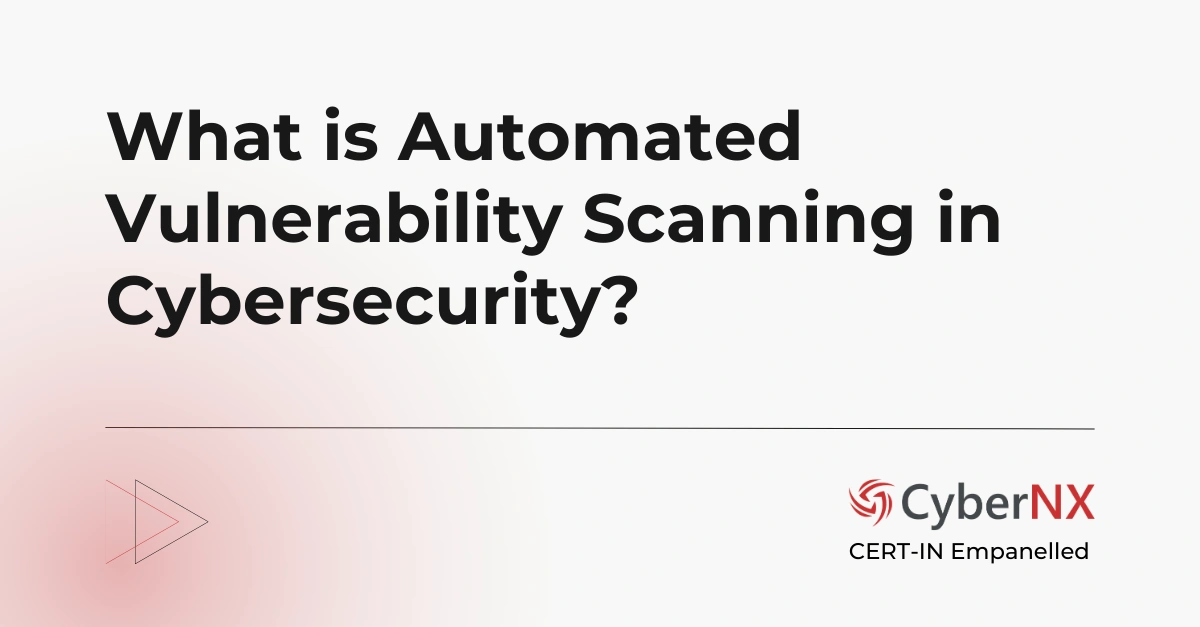Penetration testing is a simulated cyber attack on a system, network, or web app. It helps find vulnerabilities and fix them. That’s the simple definition of it. If you want to know more, we have comprehensively covered the topic of what is penetration testing in one of our previous blogs.
Here, we will go one step further and explore in-depth about types of penetration testing. Because not all types of pentest are the same. They vary in scope, purpose, methodology and the targeted systems.
Knowing the different types of penetration testing and their subtypes plus techniques will empower you to build a strong cybersecurity strategy based on your security needs.
Ready to learn? Read on.
Why Your Business Needs Different Types of Penetration Testing?
Penetration testing is one of the most implemented cybersecurity practices today along with vulnerability assessment. Primarily, this is because of the mandatory auditing and compliance requirements for industries like BFSI and Healthcare. Regulators like RBI, SEBI and government bodies like CERT-In mandate security standards to be maintained.
Public and private organizations need to find and fix vulnerabilities in their digital assets to prevent cyberattacks. Some employ pentesters in-house while others outsource the process to vendors. Our experts recommend CERT-In empanelled auditors in India.
Software is another industry that adopts penetration testing to expose flaws in the code and prevent applications from unwanted cyberattacks. At the same time, it is important to note that if your business collects, processes and stores sensitive data or uses digital assets, you need different types of penetration testing.
Who Performs Different Types of Penetration Testing?
Penetration testers or pentesters are security professionals who conduct different types of penetration testing. The certified professionals assess your IT ecosystem based on your requirements, critical assets and value cases. A scope is developed which covers every asset that needs to be tested. Various Penetration Testing tools are used to find and exploit vulnerabilities with your permission.
Types of Penetration Testing
Now, let’s explore the different types of penetration testing based on the target systems, subtypes and key focus areas.
1. Network Penetration Testing
Networks are the key component of every form of digital communication. A compromise or breach here can be devastating. You can expect data breaches, service disruption or lateral movements by the threat actor.
As cyber threats keep changing and evolving, network penetration testing is key for keeping networks safe.
Types of Network Penetration Testing: Internal vs. External
Network penetration testing is split into internal and external tests. It depends on who is doing the testing.
a. Internal Network Testing
This test looks at the network from inside. It finds weaknesses that insiders or attackers could use. The scope includes enumerating internal IPs, gaining domain admin rights and exploiting weak internal defences. Testers usually find SMB vulnerabilities and active directory misconfigurations.
b. External Network Testing
This test checks the network’s outside parts, like firewalls and servers.
It finds weaknesses that outside attackers could use. The scope covers firewall bypassing and exploiting weak DNS configurations.
Unpatched systems, weak credentials and misconfigured ports are common findings.
Key Tools used in this type of penetration testing: Nmap, Wireshark, Metasploit, Nessus
2. Web Application Penetration Testing
Web apps are constantly exposed to internet and interact with countless users. This makes the apps primary target.
Web Application penetration testing is key to keeping data safe. It helps find and fix weak spots in web apps. These spots can be targets for hackers, leading to big data breaches or financial losses.
E-commerce, customer portals and online service providers need this type of penetration testing.
Key Components of Web Application Penetration Testing
Web application penetration testing is made up of critical components like authentication checks, business logic validation, and client-side vulnerability analysis — each targeting a specific layer of the app to uncover real-world security flaws.
a. Authentication Testing
This checks for problems in login mechanisms, password policies and session tokens. It targets brute-force vulnerabilities and password reset abuse.
b. Business Logic Testing
Assess how an attacker could abuse application logic. For example, bypassing shopping cart rules and payment without authorisation.
c. Client-Side testing
Tests how the browser interacts with app and vice-versa. Plus, evaluates XSS and DOM based vulnerabilities.
Key Tools used in this type of penetration testing: Burp Suite, OWASP ZAP, Nessus
3. API Penetration Testing
APIs are key for data exchange and app functionality. They are crucial to test for security.
APIs let different apps talk to each other. If left untested, they can expose sensitive data or give unauthorized access.
Penetration testing helps identify broken authentication, excessive data exposure, and injection flaws.
Key Testing Categories in API Penetration Testing
API penetration testing involves targeted assessments across categories like authentication and authorization, protocol-specific flaws in REST, SOAP, and GraphQL, and exposure of sensitive data through insecure endpoints.
a. REST API Security Concerns
REST APIs are popular for their ease and flexibility. But, they face security issues like exposure to sensitive data and vulnerabilities in authentication mechanisms. It’s vital to protect REST APIs to avoid data breaches and unauthorized access.
b. SOAP and GraphQL Testing
SOAP and GraphQL APIs also need security checks. SOAP APIs have strict standards and security features. They should be tested for XML parsing and processing vulnerabilities. GraphQL APIs, with their flexible queries, need checks for query complexity and data exposure.
c. API Authentication and Authorization Testing
API security relies on strong authentication and authorization. Testing these ensures only authorized users access sensitive data and functions. Common issues include weak passwords, bad token management, and wrong authorization checks.
Key Tools used in this type of penetration testing: Burp Suite, OWASP ZAP, Postman, Insomnia, SoapUI
4. Mobile Application Penetration Testing
Mobile devices are everywhere, making mobile app security key. Penetration testing for mobile apps is vital. It finds weaknesses in apps to keep user data safe and stop breaches.
Types of Mobile Application Penetration Testing
Mobile penetration testing includes platform-specific testing for iOS and Android, mobile-specific threat assessments, and client-server interaction analysis to uncover security flaws across the entire mobile ecosystem.
a. Android Security Testing
Android security testing checks how secure Android apps are. It looks at the app’s code, how it stores data, and its network use. Common problems include bad data storage, weak encryption, and mishandling of sensitive information. Testers use tools and methods to mimic attacks and find weaknesses.
b. iOS Security Testing
iOS security testing checks iOS apps for security. It looks at the app’s binary, data storage, and network use for security flaws. iOS apps are often attacked through jailbroken devices, so it’s key to test under different conditions. Testers check if the app follows secure coding and can resist common attacks.
c. Mobile-Specific Vulnerabilities
Mobile apps have unique security risks. These include bad data storage, weak encryption, and library vulnerabilities. These can cause data breaches, financial loss, and harm to reputation.
Client-Side vs. Server-Side Testing
In mobile app testing, it’s important to know the difference between client-side and server-side testing. Clientside testing looks at the app itself, its code, data storage, and local security. Serverside testing checks the backend, like APIs and databases. Both are crucial for a full security check.
Understanding mobile app security is key to protecting users and data. Good mobile app penetration testing needs a detailed approach. It must cover both client-side and server-side weaknesses.
Key Tools used in this type of penetration testing: MobSF, Frida, AppUse
5. Cloud Penetration Testing
The move to cloud computing has brought new security challenges. Cloud penetration testing is now key for businesses. As more companies use cloud services, keeping these environments safe is cruical.
Platform-specific Cloud Penetration Testing
Cloud penetration testing targets platform-specific vulnerabilities across services like AWS, Azure, and Google Cloud — assessing configurations, identity policies, and exposed resources to prevent unauthorized access and data leaks.
a. AWS Penetration Testing
AWS (Amazon Web Services) is a top cloud platform. Its penetration testing checks the security of AWS resources and settings. This includes looking for weaknesses in EC2 instances, S3 buckets, and IAM roles
Specific security concerns include misconfigured security groups and overly permissive IAM policies. Also, unsecured S3 buckets are a risk. Penetration testers mimic attacks to find these issues before they can be used by hackers.
b. Azure and Google Cloud Testing
Azure and Google Cloud also need thorough penetration testing to find security gaps. This includes checking virtual machines, storage accounts, and network setups for vulnerabilities.
Azure penetration testing focuses on securing resources like Azure VMs, Storage, and Active Directory.
Google Cloud testing looks at the security of Compute Engine instances, Cloud Storage, and Kubernetes clusters.
Cloud Infrastructure Security Challenges
Cloud infrastructure faces unique security challenges, like misconfiguration, data breaches, and insider threats. Penetration testing helps companies understand their security and reduce these risks.
Container and Kubernetes Security
Containers and Kubernetes are key to modern cloud infrastructure but bring new security issues. It’s important to ensure the security of containerized apps and Kubernetes cluster.
Key Tools used in this type of penetration testing: Pacu, ScoutSuite, CloudSploit, Prowler
6. Social Engineering Penetration Testing
Understanding social engineering penetration testing is key to protecting against sophisticated cyber attacks. This type of testing focuses on exploiting human vulnerabilities rather than technical ones. It’s a crucial part of a comprehensive cybersecurity strategy.
Social Engineering Pentesting Methods
There are different methods by which social engineering pentesting is carried out. They are discussed below.
a. Phishing Simulations
Phishing simulations are a common technique used in social engineering penetration testing. These simulations involve sending emails or messages that appear to be from a legitimate source but are designed to trick recipients into revealing sensitive information.
Key aspects of phishing simulations include:
- Crafting convincing emails or messages
- Identifying vulnerable employees
- Measuring response rates to phishing attempts
b. Pretexting and Impersonation
Pretexting involves creating a fictional scenario to manipulate individuals into divulging confidential information. Impersonation, on the other hand, involves pretending to be someone else, often a figure of authority, to gain trust.
Effective pretexting and impersonation tactics can reveal significant vulnerabilities in an organization’s human defences.
c. Physical Social Engineering
Physical social engineering involves testing an organization’s physical security measures by attempting to gain unauthorized access to facilities or sensitive areas.
Measuring Employee Security Awareness
Measuring employee security awareness is crucial in understanding the effectiveness of social engineering penetration testing. This can be achieved through:
- Conducting regular training sessions
- Simulating social engineering attacks
- Monitoring employee responses
Key Tools used in this type of penetration testing: Gophish, Maltego, Social-Engineer Toolkit
7. IoT Penetration Testing
IoT devices are everywhere, and their security is a big worry. Penetration testing can help fix this. As the Internet of Things (IoT) grows, so do the risks from its vulnerabilities.
IoT penetration testing finds and uses weaknesses in IoT devices and systems. It’s key to keeping IoT safe and sound.
Core Areas of IoT Penetration Testing
IoT penetration testing involves several focused areas, from hardware inspection to firmware analysis and protocol testing, each playing a crucial role in uncovering and addressing vulnerabilities unique to IoT ecosystems. Find more information below.
a. Hardware Security Assessment
Checking IoT devices’ hardware is a big part of testing. It looks for weak spots, like bad interfaces or parts that can be hacked.
b. Firmware Analysis
Looking at IoT devices’ firmware is also important. It checks for outdated or weak protocols that hackers could use.
c. Communication Protocol Testing
IoT devices talk to others and the cloud using different protocols. Testing these is vital to find and fix any weak spots in how they send data.
d. IoT-Specific Attack Vectors
IoT devices face special threats, like being hacked, having data changed, or being shut down. Knowing these threats helps create better security plans.
Doing deep IoT penetration testing helps find and fix problems. This makes IoT systems safer for everyone.
Key Tools used in is this type of penetration testing: Shodan, Binwalk, Radare2, Wireshark
8. Wireless Penetration Testing
Organizations must focus on wireless penetration testing to protect their networks. This testing checks an organization’s wireless network security. It finds weaknesses that attackers could use.
Components of Wireless Pentesting
Wireless penetration testing focuses on identifying vulnerabilities in Wi-Fi networks, Bluetooth, and other wireless protocols. It includes testing authentication methods, encryption strength, and potential attack vectors like rogue access points or man-in-the-middle attacks.
a. Wi-Fi Security Assessment
Wi-Fi security assessment is key in wireless penetration testing. It looks at WiFi network security, including access points and encryption. Weak passwords and outdated firmware are common issues.
b. Bluetooth and RFID Testing
Bluetooth and RFID testing are also important. These technologies are in many devices but often ignored. The test checks their security, including data transmission.
c. Wireless Network Exploitation Techniques
Wireless network exploitation involves finding and using network weaknesses. Techniques include man-in-the middle (MitM) attacks, eavesdropping, and unauthorized access.
Attackers use tools to exploit these weaknesses.
Key Tools used in this type of penetration testing: Aircrack-ng, Wireshark, Kismet, Reaver
Comparative Perspectives in Penetration Testing
As types of pentest continues to evolve, understanding the different types of pen testing, approaches, methodologies, and emerging technologies is crucial. Beyond the conventional types of penetration testing, several comparative models influence the depth, accuracy, and objectives of security assessments.
1. Manual vs Automated Pentesting
Manual testing relies on human expertise to uncover complex, logic-based vulnerabilities that automated tools often miss. In contrast, automated testing uses tools to quickly identify known vulnerabilities and misconfigurations, ideal for large-scale scans and early-stage assessments.
Most organizations benefit from a hybrid approach, combining both of them. Read about the pros and cons of Manual vs Automated Penetration Testing techniques.
2. Black Box vs White Box vs Grey Box
The testing visibility model also shapes effectiveness:
- Black Box: No internal knowledge; simulates external attacks.
- White Box: Full access to systems and code; allows in-depth analysis.
- Grey Box: Partial information; balances realism and thoroughness.
Each suits different needs—black box for realistic threat simulation, white box for detailed code audits, and gray box for targeted risk assessment.
3. AI-Powered Penetration Testing
Emerging AI-powered penetration testing enhances efficiency by automating reconnaissance, pattern recognition, and threat prioritization. While AI supports scale and speed, it supplements—not replace—manual insights.
See how AI is reshaping Penetration Testing with Intelligent Automation.
Incorporating the right mix of testing types, visibility levels, and emerging technologies ensures a more comprehensive and resilient cybersecurity posture.
How CyberNX can Help You Choose Penetration Testing Types
CyberNX simplifies the complex task of choosing the right penetration testing type for your business. Our experts assess your IT infrastructure, compliance needs, and risk profile to recommend the most effective testing approach. Be it web application, cloud, network, API, or IoT penetration testing.
We align each test type with your security goals and business priorities, ensuring maximum ROI and threat coverage. With CyberNX’s consultative approach, advanced tools and CERT-In – empanelled expertise, you gain a strategic cybersecurity partner. Our seasoned professionals are always available guiding you toward stronger, smarter and continuous protection against evolving threats.
Conclusion
As you can see each type of penetration testing serves a unique purpose and specifically targets an attack surface. This makes Pentests a dynamic security strategy for the entire digital environment.
Choosing the right one from different types of pentesting is important for building cyber resiliency. Remember, security is not a one-time event but a long journey.
And in this journey, CyberNX can help you with a well-rounded cybersecurity strategy, expert-led penetration testing services which have helped countless clients across India and abroad secure their businesses.
Want to know about our comprehensive cybersecurity services offerings, contact us today!
Types of Penetration Testing FAQs
Why are different types of penetration testing necessary?
Each types of pentesting targets specific vulnerabilities like networks, applications, APIs, or cloud setups, offering complete coverage against diverse attack vectors. These variations ensure that security assessments are tailored to each system’s architecture, threat model, and exposure level, improving overall resilience.
How often should penetration tests be conducted?
At least annually, or after major system changes, to ensure evolving threats are identified and mitigated promptly. Regular testing also helps meet compliance requirements, reduce risk exposure, and detect newly introduced vulnerabilities in a dynamic environment.
Is API penetration testing different from web application testing?
Yes. This type of penetration testing focuses on endpoints, authentication, and data exchange, while web app testing covers UI, business logic, and session handling. APIs often lack visual interfaces, so testing emphasizes backend logic, improper object-level access, rate limiting, and data integrity.
What’s the role of social engineering in penetration testing?
This type of penetration testing evaluates human vulnerabilities through tactics like phishing or impersonation to assess employee awareness and response to deception. It helps identify gaps in security training, exposes insider threats, and tests how well security policies are followed under pressure.
What is the main goal of penetration testing?
The primary goal is to identify and exploit security weaknesses before attackers can, helping organizations strengthen their overall security posture. Different types of penetration testing are used to secure different systems. It provides actionable insights for remediation, validates security controls, and supports proactive risk management across digital assets.






